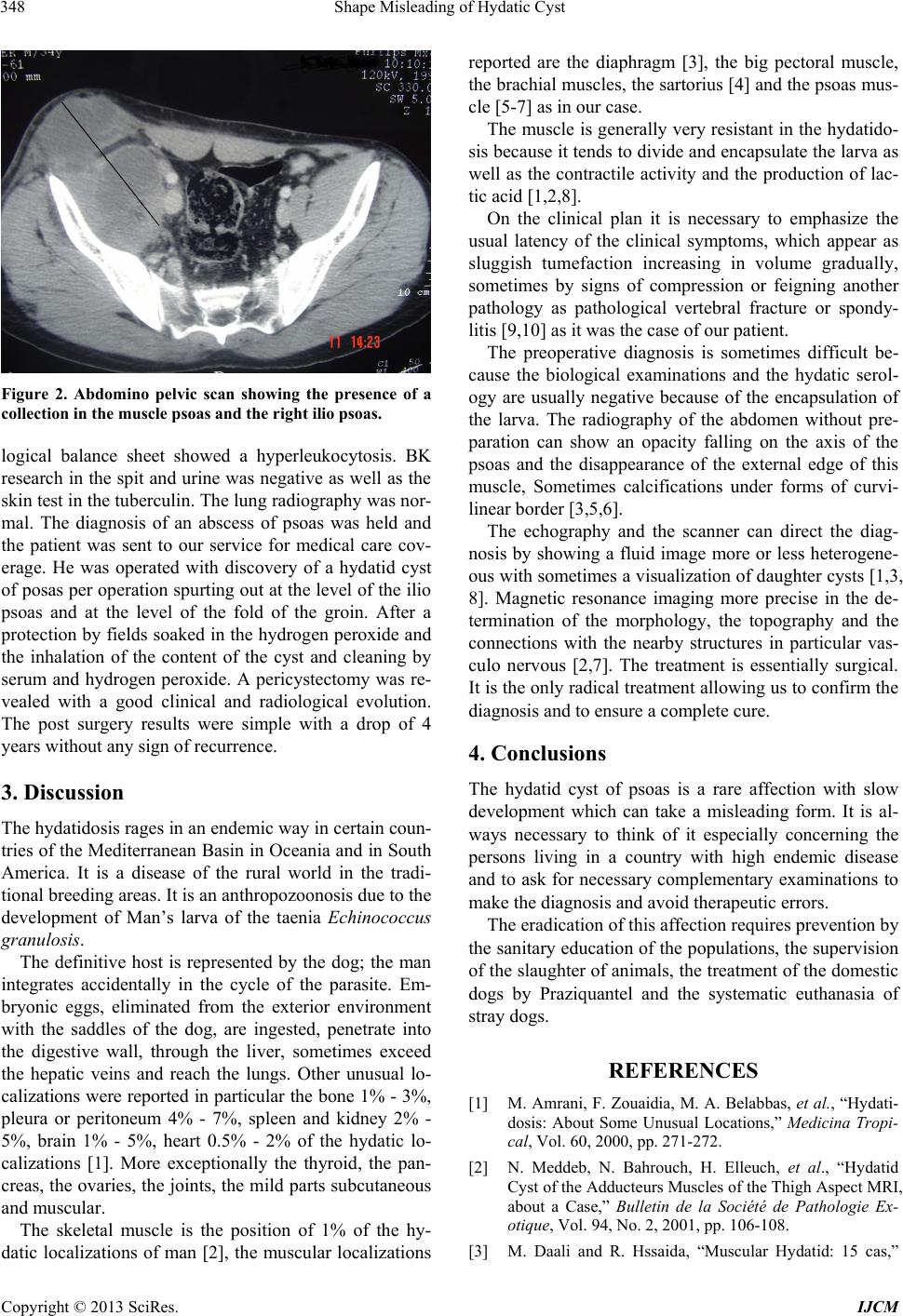
Shape Misleading of Hydatic Cyst
348
Figure 2. Abdomino pelvic scan showing the presence of a
collection in the muscle psoas and the right ilio psoas.
logical balance sheet showed a hyperleukocytosis. BK
research in the spit and urine was negative as well as the
skin test in the tuberculin. The lung rad iography was nor-
mal. The diagnosis of an abscess of psoas was held and
the patient was sent to our service for medical care cov-
erage. He was operated with discovery of a hydatid cyst
of posas per operation spu rting out at the level of the ilio
psoas and at the level of the fold of the groin. After a
protection by fields soaked in the hydrogen peroxide and
the inhalation of the content of the cyst and cleaning by
serum and hydrogen peroxide. A pericystectomy was re-
vealed with a good clinical and radiological evolution.
The post surgery results were simple with a drop of 4
years without any sign of recurrence.
3. Discussion
The hydatidosis rag es in an en d emic way in certain coun-
tries of the Mediterranean Basin in Oceania and in South
America. It is a disease of the rural world in the tradi-
tional breeding ar eas. It is an anthr opozoon osis du e to the
development of Man’s larva of the taenia Echinococcus
granulosis.
The definitive host is represented by the dog; the man
integrates accidentally in the cycle of the parasite. Em-
bryonic eggs, eliminated from the exterior environment
with the saddles of the dog, are ingested, penetrate into
the digestive wall, through the liver, sometimes exceed
the hepatic veins and reach the lungs. Other unusual lo-
calizations were reported in particular the bone 1% - 3%,
pleura or peritoneum 4% - 7%, spleen and kidney 2% -
5%, brain 1% - 5%, heart 0.5% - 2% of the hydatic lo-
calizations [1]. More exceptionally the thyroid, the pan-
creas, the ovaries, the join ts, the mild parts subcutaneous
and muscular.
The skeletal muscle is the position of 1% of the hy-
datic localizations of man [2], the muscular localizations
reported are the diaphragm [3], the big pectoral muscle,
the brachial muscles, the sartorius [4] and the psoas mus-
cle [5-7] as in our case.
The muscle is generally very resistant in the hydatido-
sis because it tends to divide and encapsulate the larva as
well as the contractile activity and the production of lac-
tic acid [1,2,8].
On the clinical plan it is necessary to emphasize the
usual latency of the clinical symptoms, which appear as
sluggish tumefaction increasing in volume gradually,
sometimes by signs of compression or feigning another
pathology as pathological vertebral fracture or spondy-
litis [9,10] as it was the case of our patient.
The preoperative diagnosis is sometimes difficult be-
cause the biological examinations and the hydatic serol-
ogy are usually negative because of the encapsulation of
the larva. The radiography of the abdomen without pre-
paration can show an opacity falling on the axis of the
psoas and the disappearance of the external edge of this
muscle, Sometimes calcifications under forms of curvi-
linear border [3,5,6].
The echography and the scanner can direct the diag-
nosis by showing a fluid image more or less heterogene-
ous with sometimes a visualization of daughter cysts [1,3,
8]. Magnetic resonance imaging more precise in the de-
termination of the morphology, the topography and the
connections with the nearby structures in particular vas-
culo nervous [2,7]. The treatment is essentially surgical.
It is the only radical treatment allowing us to confirm the
diagnosis and to ensure a complete cure.
4. Conclusions
The hydatid cyst of psoas is a rare affection with slow
development which can take a misleading form. It is al-
ways necessary to think of it especially concerning the
persons living in a country with high endemic disease
and to ask for necessary complementary examinations to
make the diagnosis and avoid therapeutic errors.
The eradication of this affection requires prevention by
the sanitary education of the populations, the supervision
of the slaughter of animals, the treatment of the domestic
dogs by Praziquantel and the systematic euthanasia of
stray dogs.
REFERENCES
[1] M. Amrani, F. Zouaidia, M. A. Belabbas, et al., “Hydati-
dosis: About Some Unusual Locations,” Medicina Tropi-
cal, Vol. 60, 2000, pp. 271-272.
[2] N. Meddeb, N. Bahrouch, H. Elleuch, et al., “Hydatid
Cyst of the Adducteurs Muscles of the Thigh Aspect MRI,
about a Case,” Bulletin de la Société de Pathologie Ex-
otique, Vol. 94, No. 2, 2001, pp. 106-108.
[3] M. Daali and R. Hssaida, “Muscular Hydatid: 15 cas,”
Copyright © 2013 SciRes. IJCM